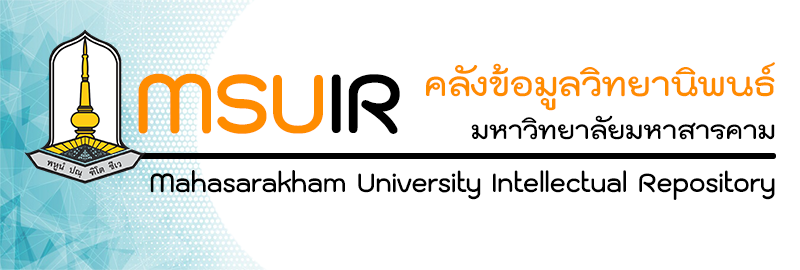Please use this identifier to cite or link to this item:
http://202.28.34.124/dspace/handle123456789/2832| Title: | THE DEVELOPMENT OF FLIPPED CLASSROOM LEARNING MANAGEMENT WITH THE TEACHING OF PRACTICAL SKILLS USING ONLINE LESSONS FOR UNDERGRADUATE STUDENTS การพัฒนาการจัดการเรียนรู้แบบห้องเรียนกลับด้านร่วมกับการสอนทักษะปฏิบัติโดยใช้บทเรียนออนไลน์ สำหรับนิสิตระดับปริญญาตรี |
| Authors: | Aphichai Suknonchan อภิชัย สุขโนนจารย์ Hemmin Thanapatmeemamee เหมมิญช์ ธนปัทม์มีมณี Mahasarakham University Hemmin Thanapatmeemamee เหมมิญช์ ธนปัทม์มีมณี hemmin.t@msu.ac.th hemmin.t@msu.ac.th |
| Keywords: | การจัดการเรียนรู้แบบห้องเรียนกลับด้านร่วมกับการสอนทักษะปฏิบัติ บทเรียนออนไลน์ ความสามารถในการพัฒนาเว็บไซต์ FLIPPED CLASSROOM LEARNING MANAGEMENT WITH THE TEACHING OF PRACTICAL SKILLS ONLINE LESSONS THE ABILITY TO DEVELOP THE WEBSITE |
| Issue Date: | 24 |
| Publisher: | Mahasarakham University |
| Abstract: | The purpose of this research were 1) to test the effectiveness of the flipped classroom learning arrangement combined with teaching practical skills using online lessons for undergraduate students, 2) to Compare the academic achievement of students who study with a flipped classroom learning arrangement combined with teaching practical skills using online lessons and students who studied with normal learning management, 3) Compare the website development abilities of students who studied with flipped classroom learning management combined with teaching practical skills using online lessons and students who study with normal learning arrangements and 4) Study of satisfaction of undergraduate students towards organizing learning in a flipped classroom format combined with teaching practical skills using online lessons. The sample group used for this research was 41 people, obtained by random sampling (Cluster Random Sampling) and divided into 2 groups: Group 1, several 21 people, designated as the experimental group, and Group 2, several 20 people, designated as the control group. The tools used to collect data include 1) learning management plans Consisting of 4 learning plans for a flipped classroom with teaching practical skills using online lessons, 4 plans for 4 hours each, totaling 16 hours, and 4 plans for normal learning, 4 hours for each plan, for a total of 16 hours. 2) Online lesson on e-learning web development with WordPress 3) Academic achievement test, 30 questions, 4 multiple choice options, 4) Website development ability test, 3 questions, and 5) Customer satisfaction questionnaire. Students, 15 questions. Statistics used in data analysis include percentage, mean, standard deviation, and t-test for Independent Sample.
The research results showed that: 1) the effectiveness of inverted classroom learning arrangements combined with practical skills teaching using online lessons for undergraduate students, 82.86/81.43 meets the criteria. 2) The academic achievement of students who learned with inverted classroom management combined with teaching practical skills using online lessons was statistically significantly higher than students learning with normal learning management at .05 level. 3) The ability to develop the website of students learning with inverted classroom management combined with teaching practical skills using online lessons was higher than students learning with normal learning management. and 4) undergraduate students' satisfaction with inverted classroom learning arrangements combined with practical skills instruction using online lessons. Overall, it is at the highest level. The overall mean is 4.79, the standard deviation is 0.46. การวิจัยในครั้งนี้มีความมุ่งหมายเพื่อ 1) ทดสอบประสิทธิภาพของการจัดการเรียนรู้แบบห้องเรียนกลับด้านร่วมกับการสอนทักษะปฏิบัติโดยใช้บทเรียนออนไลน์ สำหรับนิสิตระดับปริญญาตรี 2) เปรียบเทียบผลสัมฤทธิ์ทางการเรียนของนิสิตที่เรียนด้วยการจัดการเรียนรู้แบบห้องเรียนกลับด้านร่วมกับการสอนทักษะปฏิบัติโดยใช้บทเรียนออนไลน์ กับนิสิตที่เรียนด้วยการจัดการเรียนรู้แบบปกติ 3) เปรียบเทียบความสามารถในการพัฒนาเว็บไซต์ของนิสิตที่เรียนด้วยการจัดการเรียนรู้แบบห้องเรียนกลับด้านร่วมกับการสอนทักษะปฏิบัติโดยใช้บทเรียนออนไลน์ กับนิสิตที่เรียนด้วยการจัดการเรียนรู้แบบปกติ และ 4) ศึกษาความพึงพอใจของนิสิตระดับปริญญาตรี ที่มีต่อการจัดการเรียนรู้แบบห้องเรียนกลับด้านร่วมกับการสอนทักษะปฏิบัติโดยใช้บทเรียนออนไลน์ กลุ่มตัวอย่างที่นำมาวิจัยในครั้งนี้มีจำนวน 41 คน ได้มาโดยการสุ่มแบบกลุ่ม (Cluster Random Sampling) แล้วทำการแบ่งออกเป็น 2 กลุ่ม ได้แก่ กลุ่มที่ 1 จำนวน 21 คน กำหนดให้เป็นกลุ่มทดลอง และกลุ่มที่ 2 จำนวน 20 คน กำหนดให้เป็นกลุ่มควบคุม เครื่องมือที่ใช้ในการเก็บรวบรวมข้อมูล ได้แก่ 1) แผนการจัดการเรียนรู้ ประกอบไปด้วยแผนการจัดการเรียนรู้แบบห้องเรียนกลับด้านร่วมกับการสอนทักษะปฏิบัติโดยใช้บทเรียนออนไลน์ จำนวน 4 แผน แผนละ 4 ชั่วโมง รวม 16 ชั่วโมง และแผนการจัดการเรียนรู้แบบปกติ จำนวน 4 แผน แผนละ 4 ชั่วโมง รวม 16 ชั่วโมง 2) บทเรียนออนไลน์ เรื่อง การพัฒนาเว็บอีเลิร์นนิงด้วย WordPress 3) แบบทดสอบวัดผลสัมฤทธิ์ทางการเรียน จำนวน 30 ข้อ แบบปรนัย 4 ตัวเลือก 4) แบบวัดความสามารถในการพัฒนาเว็บไซต์ จำนวน 3 ข้อ และ 5) แบบสอบถามความพึงพอใจของนิสิต จำนวน 15 ข้อ สถิติที่ใช้ในการวิเคราะห์ข้อมูล ได้แก่ ค่าร้อยละ ค่าเฉลี่ย ค่าส่วนเบี่ยงเบนมาตรฐาน และ ค่า t-test for Independent Sample ผลการวิจัยพบว่า 1) ประสิทธิภาพของการจัดการเรียนรู้แบบห้องเรียนกลับด้านร่วมกับการสอนทักษะปฏิบัติโดยใช้บทเรียนออนไลน์ สำหรับนิสิตระดับปริญญาตรี คือ 82.86/81.43 เป็นไปตามเกณฑ์กำหนดไว้ 2) ผลสัมฤทธิ์ทางการเรียนของนิสิตที่เรียนด้วยการจัดการเรียนรู้แบบห้องเรียนกลับด้านร่วมกับการสอนทักษะปฏิบัติโดยใช้บทเรียนออนไลน์สูงกว่านิสิตที่เรียนด้วยการจัดการเรียนรู้แบบปกติ อย่างมีนัยสำคัญทางสถิติที่ระดับ .05 3) ผลความสามารถในการพัฒนาเว็บไซต์ของนิสิตที่เรียนด้วยการจัดการเรียนรู้แบบห้องเรียนกลับด้านร่วมกับการสอนทักษะปฏิบัติโดยใช้บทเรียนออนไลน์สูงกว่านิสิตที่เรียนด้วยการจัดการเรียนรู้แบบปกติ อย่างมีนัยสำคัญทางสถิติที่ระดับ .05 และ 4) ความพึงพอใจของนิสิตระดับปริญญาตรีที่มีต่อการจัดการเรียนรู้แบบห้องเรียนกลับด้านร่วมกับการสอนทักษะปฏิบัติโดยใช้บทเรียนออนไลน์ โดยรวมอยู่ในระดับมากที่สุด ค่าเฉลี่ยโดยรวมเท่ากับ 4.79 ส่วนเบี่ยงเบนมาตรฐานเท่ากับ 0.46 |
| URI: | http://202.28.34.124/dspace/handle123456789/2832 |
| Appears in Collections: | The Faculty of Education |
Files in This Item:
| File | Description | Size | Format | |
|---|---|---|---|---|
| 64010583002.pdf | 6.88 MB | Adobe PDF | View/Open |
Items in DSpace are protected by copyright, with all rights reserved, unless otherwise indicated.

